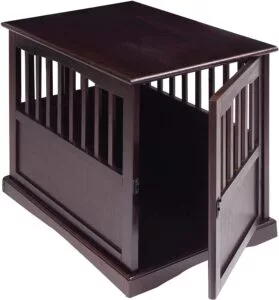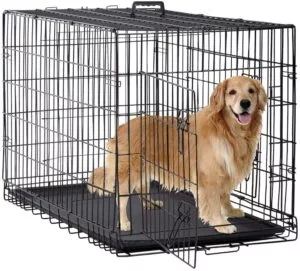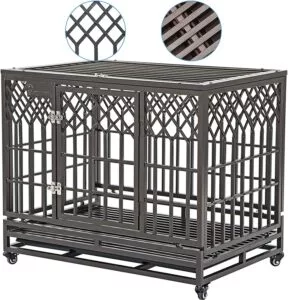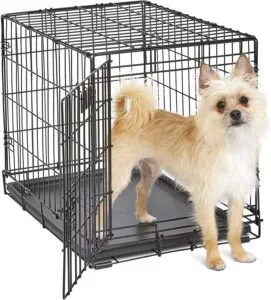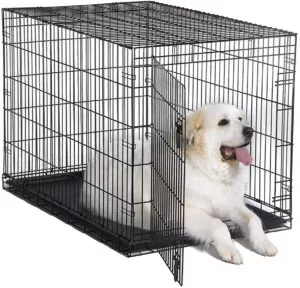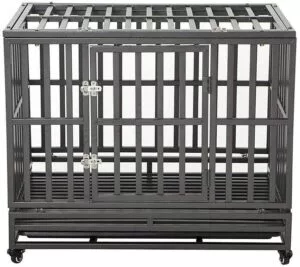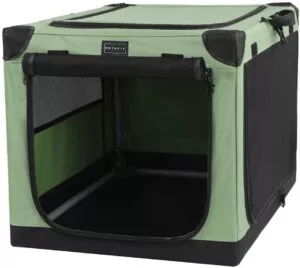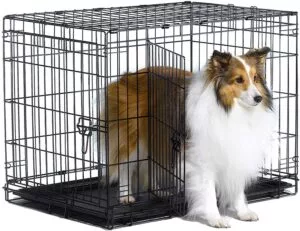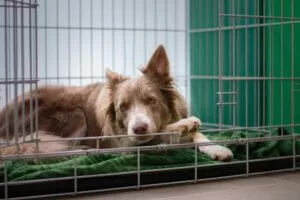
The Best Dog Crates in Canada
When it comes to owning a dog, especially new puppies, getting a proper crate and starting them early with training is a necessity. For safety, comfort, and making routines for you and your pup can make all the difference in the world when it comes to enjoying the time with your dog more than frustrations.
Choosing a crate makes all the difference and can be overwhelming with so much information, advice, and options out there in the market. With our guide below, you can take all of guesswork and stress out of the search and get to enjoying time with your new pup.
Our top picks
How to choose a dog crate
Size
If you’re getting a brand-new puppy or adopting an older dog, be sure to get the proper sized crate for them. You may need to get different sizes as your puppy grows, since they do grow very fast. A crate is first and foremost a place where they should rest, sleep, and go to when they want safety.
There should be enough room that they can easily turn around and stand without crouching, but not enough room that they can use a separate part of it as a bathroom.
Type/Style
There are several kinds of crates available and what you and your pup are the most comfortable with and have the space for is up to you.
- Wire folding dog crates are the most popular type on the market to this day. They’re strong, durable, and can be folded down for easy storage and travel.
- Soft-sided/pop-up crates are lightweight and easy for travelling or camping.
- Hard plastic dog-carrier style crates are meant for easy transportation such as to the vet or while travelling. They create a darker environment which some dogs prefer, though they also are harder to find in large sizes, and any large breeds of dogs should be used with a wire or canvas crate.
- Heavy duty style crates are often extremely heavy, hard to put together, and are only meant for destructive and strong dogs that cannot be in any other types of crates or carriers.
Temperament/Behaviour
Like with most pet products and services, your dog’s temperament and behaviour will also determine what kind of crate you should look to purchase. If you have a mellow, relaxed dog they most likely won’t need a steel cage. Any dog that is smart enough to unlock the latches, possibly bend the wire on certain cages, or other destructive behaviours – you should look into the more durable options.
Portability
Will you be needing to move it out of the way a lot during the days and need to fold it up for storage? Move it to different rooms often? Travel? Keep in mind whether you want to get a heavier crate that can stay in place most of the time, or if it’ll be moved, or even if you need a travel-friendly crate for road trips and camping.
Price
Obviously you can get very cheap dog crates on the market, but they might not be up to code for safety or durability. Expensive doesn’t always mean the best either, but you do get what you pay for and do research on the brand you’re looking at. All the picks on our list have been chosen for their reviews and use from real pet owners.
Location
Consider where your dog’s crate will be going most of the time in your home and what can fit where. If you intend to only, have it open at night and need it to fold away for storage, then be sure to keep that in mind when choosing.
Safety
This should go without saying but be sure that the crate you’re buying is safe for your pet and has proper locks so that they cannot get out. This is especially important when travelling or in the car.
The best dog crate for large dogs
BestPet Large Dog Crate
This easy to clean and foldable cog crate is a perfect basic crate to get for any larger dogs. It’s 48”, which is enough for most breeds. It also comes with a divider so that you can make it smaller if you’re starting with a puppy, so that as they grow, you can change the size of their area.
The liner is easy to clean and has an integrated lip so that any messes won’t spill onto the floor. It sets up in seconds and you don’t need any extra tools to do so. Same with folding it down into a compact flat shape for easy storage when you don’t need it out or are travelling.
A caveat for this crate would be that if you have an extra anxious dog, or a very determined strong dog, they could bend the bars on this one.
Pros
- No tools necessary for setup.
- Secure.
- Foldable.
- Easy to clean.
Cons
- Anxious dogs could be able to bend these bars.
Best dog crate for small dogs
Midwest Homes for pets crate
A simple foldable metal crate can sometimes be harder to find for very small dogs. This crate series starts at 18” with a divider included if you need it smaller, upwards to 48” for very large dogs. Crates with additional dividers are perfect for puppies that grow fast.
It can be set-up in seconds and folded down just as easily without any tools or fuss. It’s great travelling and taking with you. The leak-proof plastic pan is a solid plastic with a lip at the top so that any messes won’t leak onto your floor. It slides right out of the crate without you having to disassemble anything.
Strong dogs or ones that have severe anxiety can injure themselves and it’s always advised to watch your dog and see how they behave when you’re gone first before leaving them in their crate for any period of time.
Pros
- Divider panel is included.
- Heavy-duty slide bolt latch.
- Easy assembly with no tools.
Cons
- Large or strong dogs will be able to break the metal if determined enough.
Best heady duty dog crate
SMONTER Heavy Duty Strong Metal Crate
If you have a dog that is extremely anxious or rambunctious and they’ve broken out of every other crate or kennel you’ve tried, this Smonter heavy duty crate might be the best choice for you. The design is beautiful and the top diamond shapes ensure that they can’t get through the top corners like in other dog crates. It’s designed so that they can’t bite their way through or injure themselves on thin metal.
The heavy-duty crates do cost the most, but in these cases the safety of your dog and you is the most important thing and if they can’t be in other crates – these are your best options.
It’s easy to clean and the lipped tray at the bottom slides out and in without you needing to pull apart the crate at any point.
Pros
- Great design.
- Very durable and sturdy against anxious/strong dogs.
- Easy to clean.
Cons
- Shipped partially assembled and does require some extra work.
Best dog crate for high anxiety dogs
LUCKUP Heavy Duty Dog Cage
High anxiety dogs can benefit greatly from a heavy-duty crate. They have a far less chance of injuring themselves trying to break out and the materials are made to withstand anxious pups that bite and try to break themselves out through thinner metal bars.
It’s less anxiety on them and you knowing that they’re safe and it does give you a piece of mind when you need to leave the house for some time.
Pros
- Extremely durable.
- Safe for anxious dogs that can break out of everything else.
- Locks securely.
Cons
- It doesn’t look the best.
Best dog crate for car travel
Petsfit Portable Dog Crate for Outdoor and Travel Use
Travelling and taking your dogs for the ride is always a fun time, and if you tend to do it regularly, the Petsfit portable crate might be exactly what you’re looking for. It’s easy to clean, easy to setup, and it has two doors. The top entrance can be folded up to stay open.
There are several layers of mesh to keep it breathable and clips support and secure the zippers. It’s lightweight and foldable, which is ideal for a portable crate, especially if your car doesn’t have plenty of internal space. It can also be left open normally as a regular crate you use inside as a bed for your dog.
Pros
- Easy to bring camping, etc.
- Durable.
- Easy to clean.
Cons
- Dogs that chew can wreck the fabric.
Best budget dog crate
MidWest New World Double Door Folding Metal Dog Crate
While all dog crates seem similar, sometimes basic is best and it’s all you need, especially if you don’t want to spend too much on a crate. A heavy-duty bolt latch ensures that your pup is secure and the crate itself is easy to setup and fold down when necessary. It also has a double door for easy in and out, while the pan is lipped and easy to clean in case of any accidents.
You can also cover part of the dog crate to ensure that your dog has a cozy safe space. It’s also worth noting that for a budget dog crate, it’s really good to see double doors on this one, which can definitely be a useful feature even if you weren’t previously looking for this specification.
Pros
- Easy to setup.
- Durable.
- Heavy-duty bolt latch lock.
Cons
- Overly anxious dogs may hurt themselves on the thin metal bars.
Best dog crate for design
Casual Home 600-44 Pet Crate
We can’t deny how useful dog crates are, however, we also need to admit they aren’t the most nice-looking item for your home, especially if you’re going to keep them in your living room or bedroom.
If you’re keeping their crate in the living room and would like things to look a bit more complimentary, there are dog crates designed to fit in with furniture and other home décor. This one by Casual Home Pet Crates is a beautiful chew-resistant wood crate with a lockable gate.
The end table design works great next to your couch and is easy to clean with just a simple cloth wipe down as needed. They say that you can have up to 120lbs of weight on top of the crate, but we wouldn’t want to test that claim. The only downside is that this one is 24” large, meaning that bigger dogs may not be able to fit.
Pros
- Beautiful design.
- Easy to clean.
- Lockable.
- Chew-resistant wood.
Cons
- Not all dogs enjoy how dark it can be.
- A strong, highly anxious dog could still chew it.
Our methodology
For this article, we compared the best reviews, prices, and functions between dog crates and what is the safest and best for yourself and your dog. Considering behaviour, temperaments, size options, and additional features, so that both you as the owner, and your dog, can feel confident and enjoy your crate training together. For example, picking a good crate for a large dog is not only about size; the process should also include material, durability, chew resistance levels, ease of access, and portability. We followed a similar reasoning for each type of crate.
Questions and answers about dog crates
What are the most common types of crates?
- Wire folding dog crates are the most popular type on the market to this day. They’re strong, durable, and can be folded down for easy storage and travel.
- Soft-sided/pop-up crates are lightweight and easy for travelling or camping.
- Hard plastic dog-carrier style crates are meant for easy transportation such as to the vet or while travelling. They create a darker environment which some dogs prefer, though they also are harder to find in large sizes, and any large breeds of dogs should be used with a wire or canvas crate.
- Heavy duty style crates are often extremely heavy, hard to put together, and are only meant for destructive and strong dogs that cannot be in any other types of crates or carriers.
Is a dog crate worth it?
Dog crates are incredibly worth it. They serve as a safe separate space for your dog at home, they’re genuine lifesavers during emergencies, and is an essential part of house training a new puppy or dog.
If an emergency were to happen, it’s much easier to put your dog into their crate and leave, rather than stressing them out even further fighting to get them into it during the event, leading to injury prevention and other problems that may occur otherwise.
Crates are your dog’s safe space, and it can help a lot after surgeries for example, so they have a comfortable space to rest without being disturbed by the hustle and bustle around the house. Just like people, if they have anxiety or are scared being in a new place – they can safely retreat to their crate and feel less anxious.
Crates are irreplaceable when you’re getting a dog.
Do dogs prefer wire or plastic crates?
It depends on the dog! Some are picky, some don’t mind what their crate is made from or what design it is. Wire crates are the most common and popular, and they can also easily be covered up with a blanket, partially or fully, to give your dog a darker, safe space.
Are wire cage crates safe for dogs?
Yes, wire crates are safe for dogs – though they are recommended for larger dogs, as small teacup sized breeds may have a higher chance of injuring themselves. Another point worth noting for any dog breed that has a wire cage is to take their collar off while they’re at home, in case it ever gets caught somehow or otherwise, as there can be a risk of choking or worse.
Should I get a wooden dog crate?
Wooden dog crates can be aesthetically more pleasing than other crate options and are generally treated with moisture-resistant paint to ensure that it doesn’t mould, or scents don’t seep into the wood. They’re generally very durable and can be custom made for your dog as well.
A wooden dog crate may not be the best option though if your dog is an avid chewer and tends to gnaw on everything around itself.
Why does my puppy cry in the crate?
Puppies cry at night because they’re upset and scared. Up until you brought your new best friend home, they’ve been sleeping next to their littermates and mom every single night. It’s scary for them and they don’t understand why they’re alone now. It takes time, patience, and a whole lot of love but eventually they will get through it.
A helpful toy you can get a brand-new puppy are heated plushies that even have a function to simulate heart beats, that way your pup can snuggle up to it and have a friend to keep them company while they’re adjusting.
Is it cruel to put a puppy in a crate at night?
Puppies should sleep in their crates at night as it helps them learn to sleep through the night. Keep it next to your bed the first few weeks so that they have you around them, and so that you can easily take them out for a bathroom break whenever necessary during the nighttime.
What size dog crate do I need?
A dog crate should be big enough that your dog can turn around easily, and lay down properly, but not so big that they can move too far on either side. It’s recommended to measure your dog’s height from the top of their head and/or ears to the ground, and their length from nose to the end of their tail. Add two inches for small dogs and about four inches extra for large breeds.
Compare that to the crate sizes and you should be set! The main concern is that you don’t want a crate that’s too small – but on the flip side, if it’s too big then they can start using part of it as a bathroom spot and that’s not what you want.
Do I need a tray for my dog’s crate?
Yes, absolutely! It makes cleaning much easier and ensures that the crate itself stays durable and won’t trust or break. Avoid using towels or blankets in a dog’s crate (unless they’re older and not prone to any destruction/the crate always stays open. Any textile materials can be shredded and then become hazards or inhaled – especially if you have a new puppy. You don’t want an expensive vet trip and potential disaster.
How to crate train a puppy?
Crate training a puppy should start as soon as you bring them home. Allowing your dog to have a safe environment and a spot that is there own is invaluable and helps both you and them to get much better acquainted with routines. It especially helps potty training your dog.
- 1. Choose the right crate size for your puppy and be sure that it isn’t too large or too small.
- 2. Mindset and how your puppy views their crate is a crucial step. No negative actions such as smacking the crate when they won’t stop crying, etc. or throwing them in there as punishment. Crates aren’t ‘locking up your pet’ – it’s creating a safe space. Think of your own bedroom in a house.
- 3. Treats and positive affirmations are key when getting your new puppy accustomed to their crate. A great trick is even filling a KONG toy with some frozen peanut butter or etc. that won’t be hard to clean up but keeps them busy while they’re there. Be sure to supervise and don’t leave anything in their crate they can choke on or otherwise.
- 4. Keep in mind that puppies have very small bladders and digestive systems. They sleep a lot, but they also need to use the bathroom far more often than a grown dog. Set timers and be sure to let them go out almost immediately after eating and drinking a lot of water.
- 5. Playing games such as throwing a ball for fetch into their crate as its left open so your dog can go in and out is a great way to blow off some steam and to keep associating their crate with positive things.
- 6. Keep your pup’s collar and tags OFF when they’re in their crate at home and especially at nighttime. The tags can get caught and there is nothing more heartbreaking than a disaster happening.
- 7. Once you’re ready to leave your puppy for a few minutes in their crate, set up a camera or a phone to record and see how they behave in their crate when they realize you’re gone. Anxious? Calm? When you come back inside, reward them and give them lots of pets and love.
You don’t need to leave for a solid 8 hours but just go outside to grab a coffee and come back, a quick 10-minute venture at first.
- 8. Be patient! With your puppy and with yourself. Training a dog takes time and patience, it doesn’t happen overnight and can take years depending on your dog and how you go about it. Set yourself and them up for success, but don’t get discouraged if they make progress and then seem to go backwards for a bit. We all don’t learn overnight.
What to do if the puppy is whining in its crate?
Check to see if your puppy may have to use the bathroom or if it’s just crying to be let out. A good, suggested time for waiting is about five minutes and if they don’t settle from there, be sure to see what the matter could be.
Don’t ever raise your voice, bang on the crate, or in anyway associate their crate with punishment or being somewhere unsafe or bad. If they don’t settle after a few minutes, use their potty-training word you’ve been using to bring them outside. Puppies have small bladders and need to go outside a lot.
How to potty train a puppy?
Much like crate training, potty training your puppy is easiest when you have a routine. Crate training will take a lot of stress out of any accidents around the house and will make a massive difference with potty training as well.
Establish a routine when you wake up to bring them outside immediately. Same with after they eat and drink a lot of water. Puppies have very small bladders and stomachs and need to use the bathroom outside constantly, especially when they’re very young.
Puppy pads and paper training is great for the beginning for house training but should be more temporary. Patience and consistency are the biggest things to remember when training your dog.
Crate or playpen: Which one is the best?
Crates and puppy playpens have difference pros and cons depending on what you’re planning to use them for. If you have the space to use and utilize both – it’s a fantastic idea. If you cannot use both, then determine what you’d like either one for.
If your new dog or puppy needs to be alone for longer than four hours at a time, then a playpen is ideal so that they have space to move, go potty, and sleep in their crate – without having the free reign to destroy the house and get into trouble otherwise. They can also be useful when you are home, such as not having to worry about them getting into things while you’re cooking or in another room, for example.
Dog crates should be considered necessity when it comes to dogs and they’re perfect for emergency situations as well if the need arises.
Where to put a dog crate in the house?
If you have a new puppy or dog, keep the crate by your bed for the first few nights or weeks so that they don’t feel left alone and once they settle down and things seem alright with their crate training, and you’re sure that they can sleep through the entire night – it’s safe to move them to a different room of the house if you’d like.
How long can a dog stay in a crate?
You shouldn’t keep a dog in a crate for longer than 4-6 hours if they’re puppies of 17 weeks and older, and adult dogs shouldn’t be kept inside for longer than 6-8 hours at a time.
Should I buy a dog crate cover too?
You can cover a dog crate with a blanket or a cover, though be sure to not keep the entire thing enclosed as it needs air flow properly. If you want to get a dog crate cover when purchasing your crate, they’re generally easy to clean.
What to do if dog pees in the crate?
Clean the crate, don’t react negatively or your dog will associate their crate with bad things and we don’t want that or you’ll take steps backwards. The main two issues this happens is that their crate is too big/they have too much room or that they’re small and can’t hold their bladder. Be sure to always make sure that your dog is feeling alright as well, in case they’re sick.
When is a puppy ready to sleep out of crate?
Between 6 months and 18 months, a puppy should be ready to be left outside of their crate at night. A lot of owners simply leave their crates open, and most dogs will choose to sleep in there anyways just like normal.
What to put in a puppy crate at night?
If you have a new puppy, one of the best toys you can include are the ones that are self-heating and simulate a heartbeat so that they feel much less lonely. Avoid blankets and towels that can be shredded, and do not put food or water inside it either – they need to associate their crate with bedtime and sleeping.
Are fabric dog crates safe?
Yes, absolutely, but it depends on your dog’s behaviour. Be sure to keep an eye on whether your dog tends to chew on it or not or tries to otherwise destroy fabric and materials like soft dog crates.
Where to buy dog crates in Canada?
You can easily find dog crates at Amazon, Petland, Petsmart, Walmart, Costco, and Canadian Tire.
Read more

Top Calming Aids for Dogs
In this article we cover the best anxiety relief treatments for dogs.

The Best Cat Toys in Canada
We found the best toys for cats to ensure they can play safely at home.
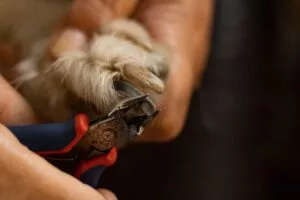
The Best Dog Nail Clippers and Grinders in Canada
Investing in a good nail trimmer causes fewer injuries and other issues.
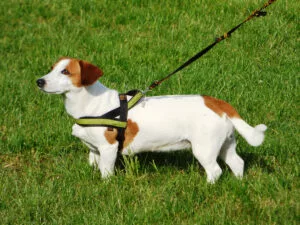
Best Retractable Dog Leashes in Canada
These retractable leashes will be suitable for most dogs.
